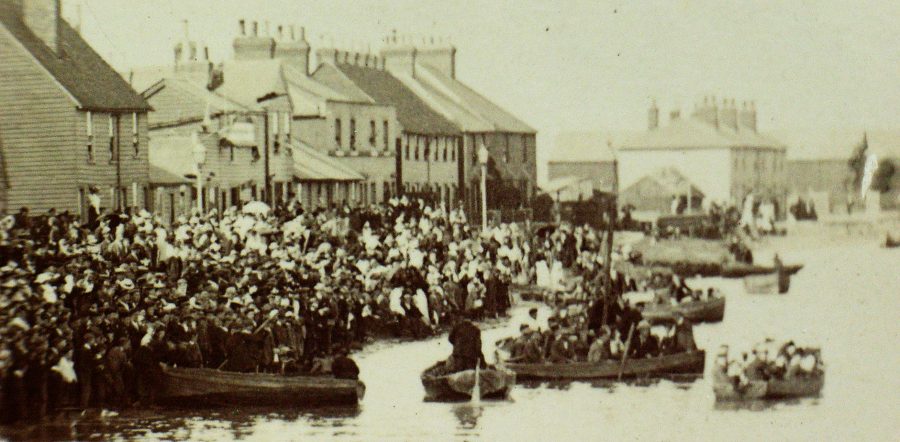We have seen how the Creek’s viability as a commercial waterway was in jeopardy after the opening of Whitstable Harbour in 1832 and how it was successfully revived at the instigation of the Municipal Charity Trustees. They promoted a scheme to improve it by ridding it of its two worst meanders, re-aligning its town centre course, and widening and deepening the whole channel from Nagden to its head, by Stonebridge Pond. Rejuvenated, the Creek re-opened to shipping in September 1843.
This investment soon earned a dividend. Port traffic steadily increased, to reach nearly 35,000 tons a year by 1868. On low-lying areas unsuitable for housing, new industry grew along its banks. In the basin a ship chandlery started on Ordnance Wharf, and a barge repair yard hard by, on the Brents bank. Fishermen could unload their catches close to North Lane, and sell them at the town end of the swing-bridge. Housing on the Brents rapidly expanded to the point that it needed its own places of worship, pubs and shops. It had its own strong sense of community, epitomised in 1908 when its people turned out in droves for a Creek regatta (pictured). John Matthew Goldfinch, the town’s leading shipbuilder, moved his yard and slipway to Standard Quay.

New employment opportunities meant increased demand for housing, and the town itself rapidly expanded to meet this. The legacy remains with us today in the shape of a rich and varied array of Victorian property. New amenities and community facilities were provided to match – the Rec, the Cottage Hospital, new schools and churches, for example.
Downsides? Yes, there were one or two. Raw sewage was still being discharged into the Creek, and the stench must have mingled malodorously with smoke from the stationary steam-engines which powered much of the new industry. It seems symptomatic that despite its historic aura and picturesque vistas Faversham was hardly ever visited by the artists who thronged towns like Rye and Sandwich. It must have been regarded as a dirty, smelly industrial place, not worth a first glance, let alone a second.
Throughout the later 19th century Creek trade continued to increase, and perhaps reached its apogee in 1895, when it handled inward trade of 446,481 tons and outward of 438,027.
In 1976, just 35 years ago, it was still a busy trading waterway. “A number of firms line its eastern bank,” reported the town’s Official Guide in 1976. “Dealing in such commodities as timber, fertiliser and animal feeds, they highlight Faversham’s function as a distribution centre for the surrounding agricultural area.” But then there was sudden, rapid decline. The last commercial cargo left in 1990, 14 years later.
Why this headlong collapse in trade? Why did the Creek emerge as a pioneer of the de-industrialisation which characterised Britain in the late 20th century? There seem to have been two main causes.
First, industry itself was in process of consolidation. To effect economies of scale, output was being concentrated on fewer, but bigger, centres of production and distribution. Second, a housing boom made industrial sites more valuable for their residential potential than for their existing uses. Governments encouraged such ‘brownfield’ redevelopments because they saved encroachments on Green Belts and farmland.
A third reason was perhaps that the Creek had lost its autonomy in 1968, when the Faversham Navigation Commission was dissolved, and its rights and duties were transferred to the Medway Ports Authority. The Authority was concentrating its attention, and resources, on the booming deep-water Port of Sheerness, and the Creek – a kind of ‘corner shop’ in relation to the shipping ‘supermarket’ of Sheerness – could not have come high in its priorities.
In the case of the Shipyard, which finally closed in 1973, there was a fourth reason. As in the case of counterparts elsewhere in Britain, it could no longer compete in international markets.